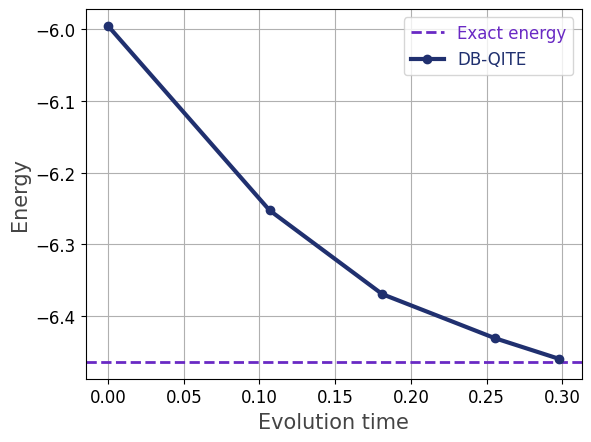Quantum Imaginary-Time Evolution#
- QITE(qarg, U_0, exp_H, s, k, method='GC')[source]#
Performs Double-Braket Quantum Imaginary-Time Evolution (DB-QITE). Given a Hamiltonian Operator \(H\), this method implements the unitary \(U_k\) that is recursively defined by either of
Group commutator (GQ) approximation:
\[U_{k+1} = e^{i\sqrt{s_k}H}e^{i\sqrt{s_k}\omega_k}e^{-i\sqrt{s_k}H}U_k\]Higher-order product formula (HOPF) approximation:
\[U_{k+1} = e^{i\phi\sqrt{s_k}H}e^{i\phi\sqrt{s_k}\omega_k}e^{-i\sqrt{s_k}H}e^{-i(1+\phi)\sqrt{s_k}\omega_k}e^{i(1-\phi)\sqrt{s_k}H}U_k\]where \(e^{it\omega_k}=U_ke^{it\ket{0}\bra{0}}U_k^{\dagger}\) is the refection around the state \(\ket{\omega_k}=U_k\ket{0}\).
- Parameters:
- qargQuantumVariable or QuantumArray
The quantum argument on which quantum imaginary time evolution is performed.
- U_0function
A Python function that takes a QuantumVariable or QuantumArray
qargas input, and prepares the initial state.- exp_Hfunction
A Python function that takes a QuantumVariable or QuantumArray
qargand timetas input, and performs forward evolution \(e^{-itH}\).- slist[float] or list[Sympy.Symbol]
A list of evolution times for each step.
- kint
The number of steps.
- methodstr, optional
The method for approximating the double-bracket flow (DBF). Available are
GCandHOPF. The default isGC.
Examples
We utilize QITE to approximate the ground state energy of a Heisenberg chain. We start by defining the lattice graph \(G\):
import networkx as nx # Create a graph N = 4 G = nx.Graph() G.add_edges_from([(k,k+1) for k in range(N-1)])
Next, we set up the Heisenberg Hamiltonian and calculate the ground state energy classically:
from qrisp.operators import X, Y, Z def create_heisenberg_hamiltonian(G): H = sum(X(i)*X(j)+Y(i)*Y(j)+Z(i)*Z(j) for (i,j) in G.edges()) return H H = create_heisenberg_hamiltonian(G) print(H) print(H.ground_state_energy())
As explained in this example, a suitable initial approximation for the ground state is given by a tensor product of singlet states \(\frac{1}{\sqrt{2}}(\ket{10}-\ket{01})\) corresponding to a maximal matching of the graph \(G\). Accordingly, we define the function
U_0:from qrisp import QuantumVariable from qrisp.vqe.problems.heisenberg import create_heisenberg_init_function M = nx.maximal_matching(G) U_0 = create_heisenberg_init_function(M) def state_prep(): qv = QuantumVariable(N) U_0(qv) return qv E_0 = H.expectation_value(state_prep)() print(E_0)
For the function
exp_Hthat performs forward evolution \(e^{-itH}\), we use thetrotterizationmethod with 5 Trotter steps:def exp_H(qv, t): H.trotterization(method='commuting')(qv,t,5)
With all the necessary ingredients, we use QITE to approximate the ground state:
import numpy as np import sympy as sp from qrisp.qite import QITE steps = 4 s_values = np.linspace(.01,.3,10) theta = sp.Symbol('theta') optimal_s = [theta] optimal_energies = [E_0] for k in range(1,steps+1): # Perform k steps of QITE def state_prep(): qv = QuantumVariable(N) QITE(qv, U_0, exp_H, optimal_s, k) return qv qv = state_prep() qc = qv.qs.compile() # Find optimal evolution time # Use "precompliled_qc" keyword argument to avoid repeated compilation of the QITE circuit energies = [H.expectation_value(state_prep, diagonalisation_method='commuting', subs_dic={theta:s_}, precompiled_qc=qc)() for s_ in s_values] index = np.argmin(energies) s_min = s_values[index] optimal_s.insert(-1,s_min) optimal_energies.append(energies[index]) print(optimal_energies)
Finally, we visualize the results:
import matplotlib.pyplot as plt evolution_times = [sum(optimal_s[i] for i in range(k)) for k in range(steps+1)] plt.xlabel('Evolution time', fontsize=15, color='#444444') plt.ylabel('Energy', fontsize=15, color='#444444') plt.axhline(y=H.ground_state_energy(), color='#6929C4', linestyle='--', linewidth=2, label='Exact energy') plt.plot(evolution_times, optimal_energies, c='#20306f', marker="o", linestyle='solid', linewidth=3, zorder=3, label='DB-QITE') plt.legend(fontsize=12, labelcolor='linecolor') plt.tick_params(axis='both', labelsize=12) plt.grid() plt.show()

In the Examples, we also show how to solve MaxCut with QITE.
